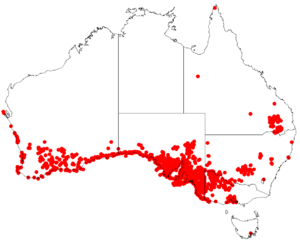Black paperbark facts for kids
Quick facts for kids Black paperbark |
|
|---|---|
 |
|
| M. lanceolata in Maranoa Gardens, Victoria | |
| Scientific classification | |
| Genus: |
Melaleuca
|
| Species: |
lanceolata
|
 |
|
| Collections data for M. lanceolata from the Australasian Virtual Herbarium | |
| Synonyms | |
|
|
Melaleuca lanceolata, often called black paperbark or moonah, is a type of plant in the myrtle family. Its scientific name is Myrtaceae. This plant grows naturally in many parts of Australia. You can find it in Western Australia, South Australia, Victoria, New South Wales, and Queensland. It's a tree with lots of leaves and rough bark. It produces many flowers, especially in summer.
Contents
What Does the Black Paperbark Look Like?
The black paperbark is a large bush or a small tree. It can grow up to about 10 meters (33 feet) tall. Its bark is rough and dark grey. The trunk often looks twisted because of the wind.
When the branches and leaves are young, they have soft, silky hairs. As they get older, they become smooth (this means they lose their hairs). The leaves grow one after another along the stem. They are usually 3.1 to 12.5 millimeters (0.1 to 0.5 inches) long. They are narrow and have a curved top surface.
The flowers are white or cream colored. They grow in spikes at the ends of the branches. Sometimes, they also grow where the leaves meet the stem. These flower spikes can be up to 60 millimeters (2.4 inches) long and 23 millimeters (0.9 inches) wide. Each spike has 3 to 12 groups of flowers, with three flowers in each group.
The petals are small, about 1.5 to 3 millimeters (0.06 to 0.12 inches) long. They fall off as the flower gets older. The plant has stamens, which are the parts that make pollen. These stamens are grouped into five bundles around the flowers. Each bundle has 7 to 20 stamens.
The black paperbark mainly flowers in summer. However, you might see flowers at other times of the year too. After the flowers, the plant makes smooth, woody seed pods. These pods are almost round and are 3 to 7.5 millimeters (0.12 to 0.3 inches) long. They are spaced along the branches.
How Did It Get Its Name?
The plant Melaleuca lanceolata was first officially described in 1820. This was done by a scientist named Christoph Friedrich Otto.
The second part of its name, lanceolata, comes from a Latin word. It means "lancelike." This name was chosen because of the shape of the plant's leaves, which look a bit like a spear or a lance.
Scientists have suggested there might be different types (called subspecies) of M. lanceolata. However, many experts treat it as one main type for now.
Where Does the Black Paperbark Grow?
The black paperbark grows in Western Australia, South Australia, Victoria, New South Wales, and Queensland. It likes to grow in areas with small, tough trees and bushes, or in open woodlands.
In Western Australia, it sometimes escapes from gardens. This means it starts growing in wild areas where it wasn't originally found. It is very common along sandy coasts and on cliffs. You can also find it further inland, usually near creeks and rivers.
Is It Protected?
The Government of Western Australia says that this plant species is "not threatened." This means it is not currently in danger of disappearing.
How Do People Use the Black Paperbark?
In Gardens and Parks
The black paperbark is a great plant for gardens or as a street tree. It flowers a lot and is easy to take care of. It can be used to create a screen or a hedge. It is a tough plant that can handle salty air, which is good for coastal areas. It grows well in most types of soil, but it needs plenty of sunshine to grow its best.
On Farms
Farmers find the moonah very useful. It makes an excellent windbreak or shelterbelt. This helps protect crops and animals from strong winds. It also provides good shade for farm animals. The wood from the tree can be used for fence posts. Its flowers attract many types of wildlife. The pollen from the flowers is also valuable for beekeeping.
See also
 In Spanish: Melaleuca lanceolata para niños
In Spanish: Melaleuca lanceolata para niños
Images for kids
-
M. lanceolata leaves, flowers and fruit in the ANBG


